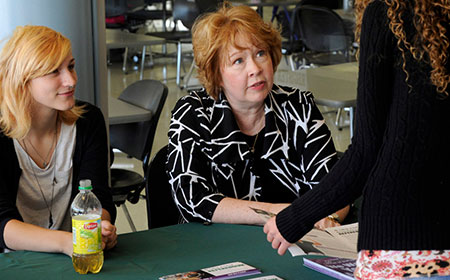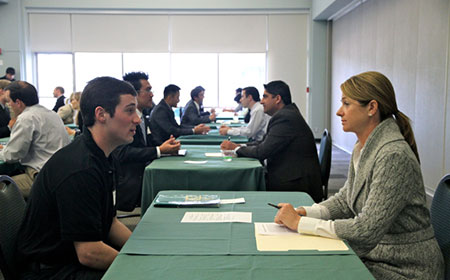By: Stephanie Brooks
You’re in college, so it’s been drilled into your head that “What you do now will affect you for the rest of your life.” Undoubtedly an education will shape your mind, influence the way you see the world, and, if everything goes according to plan, help you land a decent job. It’s a long-term investment in time, effort, and money that you hope will pay dividends.

However, you don’t want to leave college with the long-term burden of monstrous debt. The Federal Reserve Bank of New York reported the average debt for all student loan borrowers in the U.S. was $23,300 in 2011. The top 10% of all borrowers owed more than $54,000. A recent article in The New York Times examined “A Generation Hobbled by the Soaring Cost of College,” putting forth two telling statistics: “payments are being made on just 38% of the balance of federal student loans, down from 46% five years ago,” and “nearly one in 10 borrowers who started repayment in 2009 defaulted within two years.” Postponed and stopped payments were part of the reason students failed to make progress in reducing their student loan debt.
The rising cost of tuition is putting graduates in a bind, but what about those additional expenses such as room and board and food that accumulated through the years? It adds up. All your goals, dreams, and ambitions for adulthood can be put on hold because of insurmountable debt. Sound like scare tactics? It’s the real world. That’s why you should focus on cutting those other costs so that you can free up money to pay for tuition and thus free up your financial future.
Room and Board: That Other Big Expense
The College Board estimated the average cost of tuition and fees for the 2011-12 school year was $9,200 for public colleges. Compare that to the average cost of room and board and books, which was $13,203. These are the biggest expenses in many cases, and they don’t seem to receive proper attention amid the outrage surrounding tuition increases. If you want to substantially reduce the amount of debt you’ll have when you graduate, then you’ll pay close attention to how much you’re spending on this aspect of college life.
- Find a cheap dorm. Some colleges require students to live on campus for at least the first year. This means there will be several dorms on campus from which to choose and the price of each may vary. The cheaper dorms will lack the amenities, privacy, and newness of the more expensive ones, but you can compensate for that by rooming with your friends, with whom you’ll be more comfortable. Even if you don’t live with them, you’re bound to find new ones in your suite or floor who will make living there more fun.
- Consider co-op housing. A less common way to save on room and board, cooperative housing isn’t as popular as it once was but it remains an option on campuses where students are willing to work together to maintain their living space and campus. Those who are fearful of living an overly “hippie lifestyle” can attempt to organize a co-op with their friends and peers who share their values.
- Work for shelter. If you’re an upperclassmen, you can become a Resident Assistant in a dorm and receive free room and board in exchange for mentoring younger students. This, of course, requires responsibility and commitment to your place of residence, so it isn’t fit for everyone. The additional benefit is that you get to meet many new and interesting people while honing your people skills.
- Live in an off-campus apartment. Do you plan to stick around campus after the semesters end? Do you prefer to pay month-by-month? Living off campus can be more convenient than living on campus, where you have to pay a lump sum before occupying your room. In many cases, the cost of living around campus may by less than the cost of living on campus. Review apartment prices in the area surrounding your school and weigh them against the cost of the 3.5 months you would be spending in a dorm. Look for three- or four-bedroom furnished units. Dorm rates typically include utilities and other expenses such as water, trash, cable, and internet, but you may be able to find apartments that do this as well.
- If possible, live at home. You may shutter at thought of living with mom and dad, but if they live driving distance from campus, you may not be able to pass on the opportunity to save a truckload of money. It’s a solution that a lot of students are choosing. If your parents are like most parents, they’ll be pleased to have you around, and they’ll express their gratitude by providing you with warm, home cooked meals – another way to save – as long as you do your part to keep the house in tiptop shape.
Keep in mind that where you live will affect your cost of living. For example, if you grew up in a state such as Texas or Arkansas, where the average cost of living is low, and chose to attend college in a state such as California or New York, where the average cost of living is high, there will be an inevitable jump in day-to-day spending. Rooms on campus or near campus at colleges in urban areas, where space is limited, typically cost more than rooms in rural areas. Such factors should be taken into account when choosing a college to prevent financial shock once the move is made.
Sustenance, Nourishment, Grub
Colleges offer different levels of meal plans that provide a set amount of meals per semester for students who live on campus. For roughly $2,000, you can dine at the campus food hall or buy snacks and drinks from other places that sell food around campus. These are best for students’ convenience because food is always within walking distance from the dorms or class, and the cost is covered in your fee bill, preventing you from overspending on food if you rely on what’s provided by the plan.
It could be a waste of money, however, if you bought a plan covering three meals per day and you only eat two, for example. Typically those meals don’t roll over to the next semester, so you end up losing money. Cooking on your own, which requires you to buy your meals day to day and week to week, may be a better option, as it allows you to closely manage your money. When seeking nourishment off campus, do the following:
- Buy a cookbook. For the $10 you spend for a meal at a low-end restaurant, you can cook three or four meals and spread them out through the week. The Huffington Post provides some useful cheap cooking tips, advising readers to make use of Tupperware containers and a slow cooker, the latter of which is versatile and perfect for cheap cuts of meat.
- Buy store brands. Consumer Reports found that store brands save an average of 30% and are essentially indistinguishable from their more famous competitors in taste tests. The products consist of the same ingredients – the main difference is the brand on the box.
- Drink water, but don’t buy it. Drinking water instead of caffeinated beverages will not only save you money, but will also keep you healthy. Invest in a water filter that you can attach to your sink in your dorm room or apartment. Read this water filter buying guide from Consumer Reports to ensure you get one that provides great tasting water.
- Avoid eating and drinking out regularly. Few things are worse than waking up the next morning and realizing your tab was exponentially higher than you remember. Make drinks at home with your own ingredients to avoid spending too much at the bar. When drinking and eating out, frequent happy hours.
Remaining disciplined with your food purchases can be difficult, but, as you might expect, there’s an app for that: Grocery Gadget Free – Shopping List gives users the ability to compose a shopping list before going to the store, enabling them to figure out how much they will spend beforehand. Ziplist allows users to categorically organize their shopping list by isle so they can get in and out the store, avoiding unnecessary spending. You can compare prices with Grocery Pal.
Making Educated Decisions Financially
An important aspect of becoming an adult is establishing your financial well-being. In all likelihood, for the first time in your life, you’re responsible for managing your money entirely on your own. Many college students fail this initial test, causing themselves more trouble in the future. If you’re racking up student loan debt, you need to ensure you’ll be in a position to pay it off once you’ve graduated and landed a job. If you abide by these tips, then you’ll be a step ahead of many of your peers:
- Choose your checking account wisely. Some banks offer student packages that come with minimal fees and free overdraft protection in a savings account that accumulates interest.
- Use cash. Perhaps the best way to control your spending is to only have access to a certain amount of cash. As your wallet gets thinner, you’ll fully comprehend how much money you’re spending. Always pay with cash at the bar to avoid the sticker shock that follows a drunken evening with an open tab.
- Make use of auto-pay. Enroll in automatic bill-pay with your bank to ensure all your bills are paid on time each month. It’s too easy for the average college student to forget a payment because they were too busy studying or partying. On-time payments will help build your credit.
- Don’t get a credit card. You’ll eventually need one to build credit, but you shouldn’t have one unless you’ll be able to regularly pay down the balance. For most college students, the availability of the money is too tempting to resist, and they find themselves deeper in debt when they graduate.
- Don’t drive. Most college campuses and their surrounding areas are pedestrian friendly. Make use of the campus bus line and walk the rest of the way. Driving results in money spent on gas and maintenance.
- Find student discounts. Many businesses try to encourage the patronage of college students by offering reduced rates, such as airlines. Taking advantage of student discounts, wherever they’re offered, will save you lots of money over time.
Need a sidekick to help you manage your money? Check out these apps: Loot assists in budgeting, tracking repeat transactions, and account transfers. Red Laser enables you to compare prices of in-store items to thousands of other items online by merely scanning their barcode. Getting an early start on paying off your debt is essential, and Pay Off Debt helps you do just that by prioritizing your accounts.

 Rich Kiker is the Director of Online Learning at a K-12 school district in Pennsylvania, a blogger, an online professor, and a Google Certified Apps for Education Trainer. Other consulting roles include eLearning design, social learning, technology pathways development, and 1 to 1 computing. He can be reached at
Rich Kiker is the Director of Online Learning at a K-12 school district in Pennsylvania, a blogger, an online professor, and a Google Certified Apps for Education Trainer. Other consulting roles include eLearning design, social learning, technology pathways development, and 1 to 1 computing. He can be reached at  Community service is the act of volunteering toward a cause or service for a particular community, and it can be a rewarding and humbling experience. The United States
Community service is the act of volunteering toward a cause or service for a particular community, and it can be a rewarding and humbling experience. The United States 
 If a college values community service at the University itself, it likely takes note of community service experience in its applicants. Many major universities encourage their students to partake in community service activities and in some colleges it is even built into the system. For example, Eastern Connecticut State University requires four hours of community service simply to acquire a dorm room, according to an article posted in
If a college values community service at the University itself, it likely takes note of community service experience in its applicants. Many major universities encourage their students to partake in community service activities and in some colleges it is even built into the system. For example, Eastern Connecticut State University requires four hours of community service simply to acquire a dorm room, according to an article posted in 






 Of course, building the ideal education system requires a commitment in spending, but it’s how that money is spent that ultimately matters. And, according to many of our nation’s teachers, the mismanagement of their field of work has them demotivated and possibly looking for new careers. MetLife’s annual
Of course, building the ideal education system requires a commitment in spending, but it’s how that money is spent that ultimately matters. And, according to many of our nation’s teachers, the mismanagement of their field of work has them demotivated and possibly looking for new careers. MetLife’s annual  The Obama administration has vowed to listen to educators so that policymaking better meets their needs. The administering of the
The Obama administration has vowed to listen to educators so that policymaking better meets their needs. The administering of the  Teaching requires a special kind of person, and is indeed an attainable job if you’re graced with the patience and passion for the field. There are many people that find a career in teaching to be incredibly rewarding. By college, many students have caught wind of the fact that teaching pays far less than the fruits of its labor would indicate. Yet, teaching is still somewhat of a dream job for anyone who loves working with children and spreading the currency of knowledge to budding pupils. Children align teachers with superheroes. For many recent graduates, obtaining a teaching certificate serves as a backup plan in case of complete inability to find an entry-level job in their area of expertise. A teaching certificate is relatively easy to come by. With a college degree, the certificate can be obtained by simply taking a few online classes and working in a year-long internship within the field. Then there are the teaching perks that recent graduates lust after — teaching means summer and winter breaks and working shorter hours than most office jobs. At least that’s the impression that many non-teachers have.
Teaching requires a special kind of person, and is indeed an attainable job if you’re graced with the patience and passion for the field. There are many people that find a career in teaching to be incredibly rewarding. By college, many students have caught wind of the fact that teaching pays far less than the fruits of its labor would indicate. Yet, teaching is still somewhat of a dream job for anyone who loves working with children and spreading the currency of knowledge to budding pupils. Children align teachers with superheroes. For many recent graduates, obtaining a teaching certificate serves as a backup plan in case of complete inability to find an entry-level job in their area of expertise. A teaching certificate is relatively easy to come by. With a college degree, the certificate can be obtained by simply taking a few online classes and working in a year-long internship within the field. Then there are the teaching perks that recent graduates lust after — teaching means summer and winter breaks and working shorter hours than most office jobs. At least that’s the impression that many non-teachers have. The artist represents a slew of childhood dream jobs; not just fine artists, but also ballerinas, actresses, poets, and any other creative job that depends mainly on talent and knowing the right people. Students take various journeys to accomplish these career paths, some at major Universities and others at trade schools or academies made specifically to train the student in the arts. Funding an art, film, or acting education can be costly without much to show for it. While schools like New York University’s Tisch School of the Arts serve as acclaimed institutes for learning and practicing the arts, not every art school graduate will become a starlet. Some struggle for years to find success in a heavily saturated market. Even if they are talented, a writer may not be able to get through to a publisher willing to pick up their work, while debatably poorly written novels such as The Twilight Saga continue to make Best Seller lists. An artist may work three jobs just to pay the bills so they can paint in their spare time, only to be turned away from gallery after gallery. Actors audition for hundreds of roles, hoping to land even non-speaking parts. Making that big break simply isn’t easy, and for some, it never comes.
The artist represents a slew of childhood dream jobs; not just fine artists, but also ballerinas, actresses, poets, and any other creative job that depends mainly on talent and knowing the right people. Students take various journeys to accomplish these career paths, some at major Universities and others at trade schools or academies made specifically to train the student in the arts. Funding an art, film, or acting education can be costly without much to show for it. While schools like New York University’s Tisch School of the Arts serve as acclaimed institutes for learning and practicing the arts, not every art school graduate will become a starlet. Some struggle for years to find success in a heavily saturated market. Even if they are talented, a writer may not be able to get through to a publisher willing to pick up their work, while debatably poorly written novels such as The Twilight Saga continue to make Best Seller lists. An artist may work three jobs just to pay the bills so they can paint in their spare time, only to be turned away from gallery after gallery. Actors audition for hundreds of roles, hoping to land even non-speaking parts. Making that big break simply isn’t easy, and for some, it never comes. The childhood notion of becoming a fireman encompasses any job that involves both adventure and danger. Firefighters live a noble existence and they are modern day superheroes, but the job is anything but easy. In order to become a firefighter, the applicant must endure rigorous physical training and complete written exams. Once on the job, they typically work
The childhood notion of becoming a fireman encompasses any job that involves both adventure and danger. Firefighters live a noble existence and they are modern day superheroes, but the job is anything but easy. In order to become a firefighter, the applicant must endure rigorous physical training and complete written exams. Once on the job, they typically work  Most children love animals, and so a career in the animal industry seems like a dream come true. Whether they visualize working at a zoo, as a lion tamer, as a show dog breeder, or a veterinarian, the appeal is derived from working alongside loving, cuddly animals. However, many of these jobs are either low in pay or do not necessarily revolve around vying for an animal’s affections all day. While zookeepers are responsible for keeping the exotic animals within the zoo happy and healthy, much of the work involves cleaning stalls, scooping up fecal matter, and leaving out food. The zookeeper doesn’t come in direct contact with the actual animals unless they are sedated, as they are dangerous. They generally work weekends and holidays, given that the animals need care at all times. To work as a zookeeper, one must have an educational background in the field, with a bachelor’s degree in a field such as veterinary technology, zoology, or a related
Most children love animals, and so a career in the animal industry seems like a dream come true. Whether they visualize working at a zoo, as a lion tamer, as a show dog breeder, or a veterinarian, the appeal is derived from working alongside loving, cuddly animals. However, many of these jobs are either low in pay or do not necessarily revolve around vying for an animal’s affections all day. While zookeepers are responsible for keeping the exotic animals within the zoo happy and healthy, much of the work involves cleaning stalls, scooping up fecal matter, and leaving out food. The zookeeper doesn’t come in direct contact with the actual animals unless they are sedated, as they are dangerous. They generally work weekends and holidays, given that the animals need care at all times. To work as a zookeeper, one must have an educational background in the field, with a bachelor’s degree in a field such as veterinary technology, zoology, or a related 










 Social media is a pervasive part of our lives. It’s everywhere. It has shrunk the world, replacing traditional, less efficient means of communication. It has changed marketing and the way companies do business. In fact, if you’re a business that doesn’t utilize social media, then you’re not maximizing your business’s promotional potential.
Social media is a pervasive part of our lives. It’s everywhere. It has shrunk the world, replacing traditional, less efficient means of communication. It has changed marketing and the way companies do business. In fact, if you’re a business that doesn’t utilize social media, then you’re not maximizing your business’s promotional potential. The ways in which we learn are constantly changing, as new theories are brought forth, tested, and implemented. But
The ways in which we learn are constantly changing, as new theories are brought forth, tested, and implemented. But  A study conducted in 2011 by researchers in China and Hong Kong,
A study conducted in 2011 by researchers in China and Hong Kong,  Forward-thinking educators realize that the current generation of students knows only a world with the presence of the internet. For a large portion of high school students, social media has been around for half their lives. They’re dependent on it. So why not use it to their advantage educationally? However, to teachers who subscribe to more traditional methods, or perhaps those who are just more cautious, social media is little more than a distraction.
Forward-thinking educators realize that the current generation of students knows only a world with the presence of the internet. For a large portion of high school students, social media has been around for half their lives. They’re dependent on it. So why not use it to their advantage educationally? However, to teachers who subscribe to more traditional methods, or perhaps those who are just more cautious, social media is little more than a distraction.